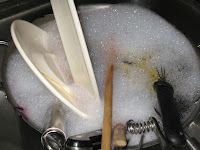 I think it's an accomplishment for a different reason. Every weekend, and yes I do mean EVERY weekend, I buy at least two 1/2 flats of fruit. Ostensibly, I buy this much fruit in order to can it but every weekend I somehow manage to eat both 1/2 flats of berries before I can make jam. Sometimes they make it into a dessert for a party, but usually I just pop handfuls into my mouth every time I'm in the kitchen. *snarf*
I think it's an accomplishment for a different reason. Every weekend, and yes I do mean EVERY weekend, I buy at least two 1/2 flats of fruit. Ostensibly, I buy this much fruit in order to can it but every weekend I somehow manage to eat both 1/2 flats of berries before I can make jam. Sometimes they make it into a dessert for a party, but usually I just pop handfuls into my mouth every time I'm in the kitchen. *snarf*I decided Sunday was the day to make jam. I received several pounds of ripe apricots from a friend (someone who clearly knows that's a gift I'd love!) She was hoping to make jam herself, but was heading out on a trip and didn't have time. It's harder for me to O.D. on apricots than berries for some reason, so I pitted them, tossed them in a pot, then actually read the recipe thoroughly and realized that they needed to macerate for 24 hours. *

Simmering apricots *** Blueberry goop


Processing the jam ** Unholy dishes** Sticky pan
As I was simmering and sterilizing and processing, a question occurred to me. Most jam recipes direct the cook to "skim the foam off" of the simmering mixture. As I cooked the blueberry jam, I began to wonder why. I couldn't really see the foam on the blueberry goop, and was having trouble skimming it without picking up berries. As I skimmed the apricot goop, I began to wonder if we skim in order to keep clarity in the jam. The foam was more easily discernible on the apricots, and I could see how it might cloud the finished product. Does anyone out there know why we skim? I'm interested in your theories.
As I've been typing, the jam has cooled and I've heard the lids begin to "ping." This is a sign of jars that have sealed successfully. I feel a sense of contentment that I don't always feel in the hurly-burly of my everyday cookery. I think that jam is called "preserves" for a reason. I have put something by for the future. This is the most basic element, and my most basic joy in cooking and eating locally. Tonight, I captured this moment in time in a half-pint jar. The freshest fruit, in season, with a minimum of fuss. In October, when flats of berries are just a dream, I'll be able to open a bottle of jam and taste this summer--its hot days and heavy rains. Although, I might not be able to wait that long.




